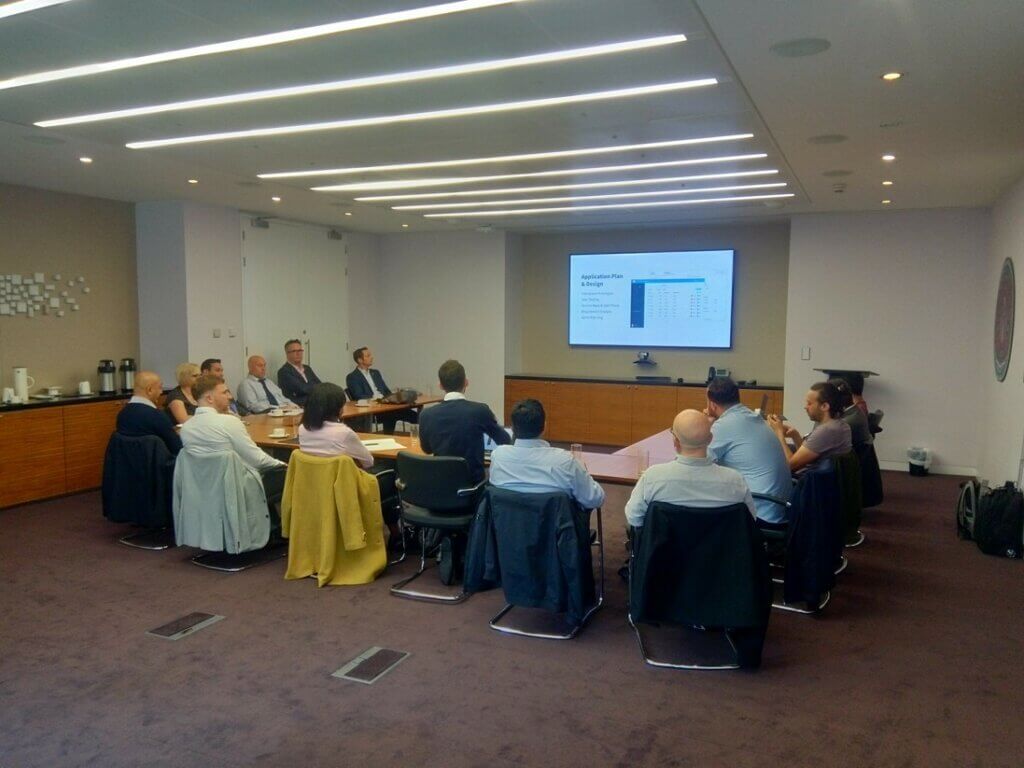 Azure AI Chatbots was the topic of the 4th SAM Club Azure User group meeting, the meeting was kindly hosted by Gardiner & Theobald at their offices in London.
Azure AI Chatbots was the topic of the 4th SAM Club Azure User group meeting, the meeting was kindly hosted by Gardiner & Theobald at their offices in London.
The conversations started with a client who is looking at developing Chatbots in Azure discussing the reasons they are considering AI Chatbots. Law firms are increasingly being asked what makes them different from their competitors. Technology is included in this for example: Can they get 24-hour access to policies that can be accessed via mobile apps? Chatbots can be developed to offer these services.
Microsoft invited ANS who are one of only 40 Azure Managed Service Partners (MSP) globally, but headquartered in the UK, who develop and design Chatbot’s. Chatbot’s are more than just a frequently asked question (FAQ) function on a website. The truth is the technology behind it is much more versatile.
Some examples of the different types of bots mentioned were:
-
- ExperienceBot
For a website to help a prospect to find the right contact within a firm. An ExperienceBot could help point someone in the right direction of partners with the relevant knowledge.
-
- StaffBot
Employees wanting to know how many days holiday they have, requesting holiday, maternity benefits etc this could all be accessed via the bot rather than contacting HR. Chatbots are not only able to automate tasks, they can be proactive. Feedback provided into the bot from staff can help answer common queries and can also be used as an anonymous way to capture data.
-
- SupportBot
How many support calls are being received on what topics and it is possible to automate the responses to reduce the number of calls and increase response times.
A Chatbot is only limited by your own creativity. Could we see websites where you answer a few questions such as looking for a new car which then returns all makes and models for consideration?
An example of a successful Chatbot use case is the ‘Do Not Pay’ chatbot that was developed by Stanford University student, Joshua Browder. It is now perhaps the most recognisable name of any legal chatbot and is now known as “The world’s first robot lawyer”. It was developed to help users contest parking fines and has helped save motorists $13 million in parking fines.
The bot is now giving free legal aid to users through a simple-to-use chat interface. The chatbot, using Facebook Messenger, can now help refugees fill in an immigration application in the US and Canada. For those in the UK, it helps them apply for asylum support.
ANS created a parking Chatbot to help assist with their staff parking, using a camera in their carpark and data sources such as staff holidays, meetings and weather they can predict when parking spaces might be available.
A Chatbot can never answer every question that anyone will ask. But built in ‘error’ replies such as ‘I don’t know the answer but can ask someone to contact you’ can help. Gathering information on additional questions can then be beneficial to develop the Chatbot further.
ANS have created a ‘BaseBot’ which is free to download on GitHub that enables you to deploy an AI powered Chatbot in under 1 hour. A great starting point for a simple Chatbot for a pilot.
Microsoft offer an QnA Maker in Azure where you can create a simple FAQ service from existing content. This offers an ideal starting point for organisations thinking about Chatbot technology and can be set up for only a small investment.
There are many off the shelf bot technologies, but if more bespoke Chatbots are required then working in partnership with a developer is recommended so they can integrate your data and build to your specific requirements.
A final use case that ANS presented was with Staffordshire University, they developed an AI-driven coach and support assistant using intelligent Chatbot technology. It provides students with key information such as course timetables, campus facilities and extra-curricular activities. It is also a support tool to help identify any at-risk individuals who may be unhappy or unsettled and provide guidance and support.
Feedback from the roundtable highlighted resistance from partners and how to drive change and get buy in, as there can be too much technology. The suggestion is always to start small with a pilot group that can then champion the concepts. ANS recommended a collaborative approach; upfront involvement from partners to discuss their pain points with developers who can translate that into what’s possible with AI Chatbot technology. Also starting off with a version one of a Chatbot to prove it’s use, then develop it further with internal and external data.
Next Azure User Group
The meeting rounded off with discussion on the topic for the next event which was agreed as Microsoft Cloud Assessments. This process looks at client’s workload on-premise and works out the costings/commercials for moving to Azure with a detailed report. The next event will be held in early August and will be announced soon.
You can find blog articles from our previous events here:
Azure User Group meeting
Azure User Group meeting 2 Dev /Test
Azure User Group meeting 3 Security & Compliance
